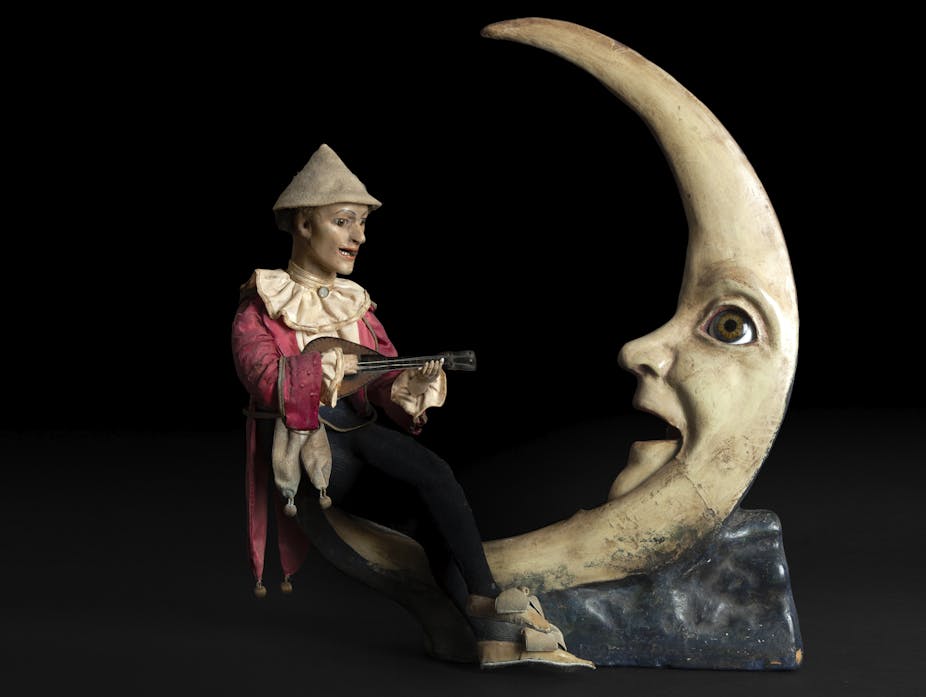The Who’s lead singer Roger Daltrey and his wife Heather are auctioning a selection of rare mechanical devices called automata in Edinburgh, Scotland. Automata are models of people or animals from previous centuries that appear to be moving independently but are actually animated by a hidden clockwork mechanism. They were a form of artificial intelligence that took the world by storm long before the digital age. For too many of us, their fascinating story has been forgotten.
Automata might look like children’s toys, but they were actually virtuoso feats of engineering that could once be found in Europe’s most prestigious royal collections. The eminently fashionable French queen Marie Antoinette owned La Joueuse de Tympanon, for example, a young woman seated at an old stringed instrument commonly known as a dulcimer.
When the device was wound up, the automaton’s hands struck the instrument’s strings, directed by a revolving cylinder hidden under her skirt. It could play no fewer than eight different melodies. The device was later restored by the 19th century master magician Jean Eugène Robert-Houdin – on whom Harry Houdini styled himself.
In fact, automata date back as far as antiquity. In the fifth century BC, the Greek scientist Archytus is said to have designed an artificial dove, probably powered by steam, that was able to fly roughly 200 metres. Records from the third century BC suggest that mechanical birds and life-sized human figures were also produced in ancient China.
In later centuries, automata were valued for the complexity and variety of their movements: the more life-like, the more skilled the craftsman. Even Leonardo da Vinci tried his hand, designing a “mechanical knight” in the late 1400s that could imitate human movements through an internal system of pulleys.
The devices reached peak popularity during and after the Enlightenment, however, becoming prized examples of human ingenuity and advanced engineering. The Daltreys’ collection contains several great examples of their capabilities. Designed by the likes of Léopold Lambert, one of the foremost craftsmen in late 19th century France, they include models that can drink a cup of tea, twirl an umbrella, strum an instrument or perform a magic trick – all while blinking their eyes or moving their lips.
Devices such as these attract private collectors and major museums. They are valued on their craftsmanship, the ingenuity and complexity of design, and of course, the working condition of their animating mechanism. The Daltreys’ collection is expected to fetch up to £50,000.
Defecating ducks and chessbots
Perhaps history’s most unusual automaton was the Digesting Duck, designed by the French inventor Jacques de Vaucanson. This mechanised fowl could move and quack and even “digest” food. De Vaucanson claimed this digestion involved a chemical decomposition process, though in truth the bird was consuming oats only to secrete artificial excrement through a concealed mechanism.
Other advanced specimens could draw, dance, play games and even speak. In St Petersburg, Abbot Mical created a device in 1780 featuring two heads on a pedestal that could have a brief dialogue with each other. Their voices were produced by passing air through hidden artificial vocal chords that covered stretched membranes. The resulting tones were deemed by the Academy of Science to be an imperfect but ingenious imitation of the human voice.
Another inventor whose automata were capable of imitating speech was a Hungarian named Wolfgang von Kempelen. Yet Von Kempelen’s greatest success was his chess-playing “mechanical Turk”. This creation could move pieces across the board and, to the astonishment of viewers, actually play against human opponents.
The mechanical Turk was so accomplished at chess that he outwitted eminent thinkers such as the American statesman Benjamin Franklin – as well as Catherine the Great and Napoleon Bonaparte. Some suspected a fraud, but the Turk successfully toured Europe for several decades following his debut in 1770. It was only later that the detractors were proven right: it was actually controlled by a chess master concealed within the device.
From cogs to computation
Automata were not merely objects of entertainment. They were seen to embody high philosophical concepts. Their mechanisms were compared, for example, to Sir Isaac Newton’s “clockwork universe”, which postulated that the physical world and perhaps even all of nature resembled a great mechanical clock.
The mechanisms of these devices were also for a long time at the forefront of European industrial technology. De Vaucanson, inventor of the Digesting Duck, also built the world’s first completely automated loom in 1745.
Ultimately, automata were also instrumental to modern industrialisation. Look no further than Victorian polymath Charles Babbage, considered by many as the “father of the computer”, who was famously fascinated by them. In short, devices like the ones being auctioned by the Daltreys are so much more than antique curiosities. They are a reminder of our enduring drive towards technological progress. The boundary between human and machine has been blurring not for decades, but for centuries.


